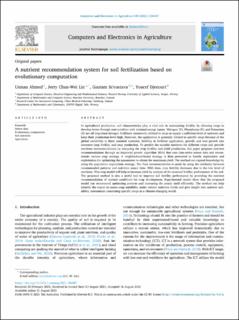| dc.contributor.author | Ahmed, Usman | |
| dc.contributor.author | Lin, Jerry Chun-Wei | |
| dc.contributor.author | Srivastava, Gautam | |
| dc.contributor.author | Djenouri, Youcef | |
| dc.date.accessioned | 2022-02-07T10:06:06Z | |
| dc.date.available | 2022-02-07T10:06:06Z | |
| dc.date.created | 2021-11-03T13:41:47Z | |
| dc.date.issued | 2021 | |
| dc.identifier.citation | Ahmed, U., Lin, J. C.-W., Srivastava, G., & Djenouri, Y. (2021). A nutrient recommendation system for soil fertilization based on evolutionary computation. Computers and Electronics in Agriculture, 189, 106407. | en_US |
| dc.identifier.issn | 0168-1699 | |
| dc.identifier.uri | https://hdl.handle.net/11250/2977425 | |
| dc.description.abstract | In agricultural production, soil characteristics play a vital role in maintaining fertility by allowing crops to develop better through root nutrition with minimal energy inputs. Nitrogen (N), Phosphorus (P), and Potassium (K) are all important nitrogen fertilizers extensively utilized in crops to supply a sufficient level of nutrients and keep their production level high. However, the application is generally limited to specific crops because of the global variability in these essential nutrients. Stability in fertilizer application, growth, and root growth rate increases crop fertility and crop production. To predict the suitable nutrients for different crops and provide nutrients recommendations by analyzing the crop fertility and yield production, this paper proposes nutrient recommendations through an improved genetic algorithm (IGA) that uses time-series sensor data and recommends various crop settings. A neighborhood-based strategy is then presented to handle exploration and exploitation for optimizing the parameters to obtain the maximum yield. The method can expand knowledge by using the population exploration strategy. The final recommendation is made by using the similarity between recommended patterns and real-time sensor data. With time, crop fertility decreases due to the low level of nutrients. This crop model will help to increase yield by analysis of the seasonal fertility performance of the soil. The proposed method is also a useful tool to improve soil fertility performance by providing the nutrient recommendation of optimal conditions for crop development. Experimental results show that the proposed model can recommend optimizing patterns and increasing the yearly yield efficiently. The method can help identify the region to assess crop suitability under certain nutrients levels and give insight into nutrient suitability assessments concerning specific crops in a climate-changing world. | en_US |
| dc.language.iso | eng | en_US |
| dc.publisher | Elsevier | en_US |
| dc.rights | Navngivelse 4.0 Internasjonal | * |
| dc.rights.uri | http://creativecommons.org/licenses/by/4.0/deed.no | * |
| dc.title | A nutrient recommendation system for soil fertilization based on evolutionary computation | en_US |
| dc.type | Peer reviewed | en_US |
| dc.type | Journal article | en_US |
| dc.description.version | publishedVersion | en_US |
| dc.rights.holder | © 2021 the Author(s). | en_US |
| dc.subject.nsi | VDP::Landbruks- og Fiskerifag: 900::Landbruksfag: 910 | en_US |
| dc.subject.nsi | VDP::Matematikk og Naturvitenskap: 400::Informasjons- og kommunikasjonsvitenskap: 420 | en_US |
| dc.source.volume | 189 | en_US |
| dc.source.journal | Computers and Electronics in Agriculture | en_US |
| dc.identifier.doi | 10.1016/j.compag.2021.106407 | |
| dc.identifier.cristin | 1951020 | |
| dc.source.articlenumber | 106407 | en_US |
| cristin.ispublished | true | |
| cristin.fulltext | original | |
| cristin.qualitycode | 2 | |

